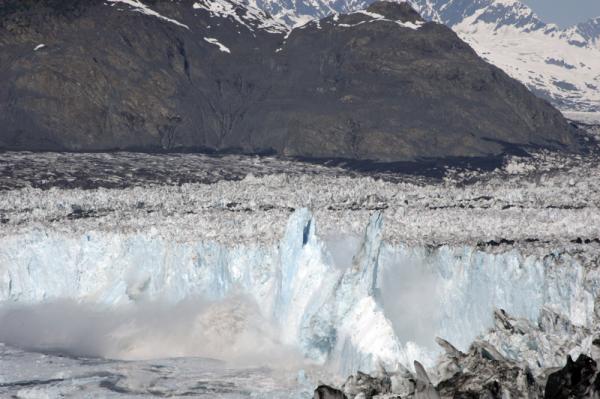
Glacier Once Stuck to Sea Floor, Breaks Loose

An Alaskan glacier has lost its footing with the seafloor and is floating in the ocean, new first-of-their-kind observations show.
The observations have implications for predicting the sea level rise that could accompany global warming and the melting of glaciers around the world.
Glaciers are huge rivers of ice formed when snow and ice accumulate over hundreds and thousands of years. They are found at the Earth's poles and in some mountain ranges. These icy rivers move slowly over time, some eventually dumping ice chunks into the sea, a process known as calving — a leading source of additional water for the world's oceans.
"It's like a big conveyor belt pushing the ice out to the sea," said glaciologist and team member Shad O'Neel of the U.S. Geological Survey in Anchorage, Alaska.
Some glaciers are what are called "grounded," meaning they rest on the ocean floor, while others float on top of the ocean waters as they run into the sea.
Scientists previously thought that only glaciers with sturdy, cold ice, such as in Greenland, could form floating tongues. But Alaska's Columbia Glacier, a previously grounded glacier with weaker ice, is showing that the case isn't quite that simple. [See scientists studying the glacier.]
Surprise floater
Get the world’s most fascinating discoveries delivered straight to your inbox.
The study of Columbia Glacier, a tidewater glacier, shows the first detailed observation of a glacier undergoing a transition from grounded to floating.
Tidewater glaciers flow directly into the ocean, ending at a cliff in the sea, where icebergs are formed. Prior to this study, Alaskan tidewater glaciers were believed to be exclusively grounded and unable to float without disintegrating.
The switch in glacier style is important, because unlike floating glaciers, grounded glaciers calve icebergs nearly continuously, which means they generally form smaller icebergs. The Columbia Glacier had been continuously calving so that ice was always flowing down toward the sea, creating icebergs roughly every hour.
Floating glaciers, such as the one that developed at Columbia in 2007 produce more massive icebergs once a week, much slower than grounded glaciers that form icebergs hourly.
The reason Columbia Glacier began floating may have been because it was receding so fast that its extension into the water began floating before it was able to break off into an iceberg, the study suggests.
When glaciers go into retreat mode, as they are now, they accelerate toward the sea and lose a large amount of ice. Since 1980, Columbia Glacier has retreated nearly 12 miles (20 kilometers) and is now moving between 66 and 98 feet (20 and 30 meters) a day, making it one of the fastest receding glaciers in the world.
"We're seeing more tidewater glaciers retreat," said glaciologist and team member Fabian Walter of the Scripps Institution of Oceanography, in La Jolla, Calif. "As they retreat, they thin, and that increases the likelihood that they'll come afloat."
Modeling sea level rise
Scientists have no idea how to put the different types of calving into a sea level rise model, O'Neel told OurAmazingPlanet.
To fill in the holes in the sea level rise models, the researchers used a sensor that measures seismic waves and tracked the glacier calving. These seismic data let the scientists compare the glacier's activity before and after it began floating.
Through this study, scientists can begin to analyze the mechanics of the calving process to allow them to better understand and predict iceberg production from glaciers and ice sheets. These predictions, in turn, will provide a more accurate estimate of sea-level rise in the coming years.
The study will be detailed in an upcoming edition of the journal Geophysical Research Letters.
This article was provided by OurAmazingPlanet, a sister site to LiveScience.
 Live Science Plus
Live Science Plus





